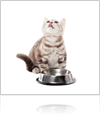
One of the major components of pet health is proper nutrition, knowing what to feed your kitten, providing meals according to the right schedule, and also ensuring that the way you are feeding your kitten will not create health problems such as obesity later in life. Read on to learn how to help your kitten get a healthy start to life and the New Year.
Kittens can start to be weaned after their first four weeks, finishing the transition once they have reached around eight weeks old. Due to their rapid growth and development, plus their high energy, kittens require a great deal of calories; they can have as much as three times the energy needs of a full-grown cat. No less than three to four meals a day is typical for a kitten's needs and wants. Kittens have similar needs for fat, fatty acids, and vitamins as do adult cats. But kittens need to draw around 30 percent of energy from protein sources; they also need more amino acids, minerals, and certain vitamins than do adult cats. That is why kitten-specific food is ideal for your pet until your kitty is about one year old. Also a key part of a kitten's diet: hydration. Make sure your kitten is able to drink lots of water. This is a need they will never outgrow.
So wet food or dry food? Tiny kittens should eat some canned food; their small teeth are not a good match for dry food. The only way they can get the energy they need is to get some wet food in their diet. If you are feeding your kitty both dry and wet food, then your kitten should be covered if two of their meals are canned food. If you are feeding your kitten canned food exclusively, then you should feed them this four times a day.
What happens when you need to change out your kitten's food? It can be difficult enough as it is to get a cat to accept what you offer. But you will make your job easier if you vary your kitten's food so that they get used to all manner of flavors and textures, as opposed to becoming accustomed to only one type of food. When it comes time to switch your kitty's meals, you probably should not put the old and new food together; this strategy could backfire, putting the kitten off of both the new and the old meal. Each type of food should get its own bowl. Then you should decrease the amount of old food over the next four to seven days, getting your kitten to try out the new food in the other bowl. If you try the switch any faster, your kitten, or its stomach, may revolt.
As much as a kitten needs to eat when they are younger, it is important to gradually lessen their meals, lest they regularly overfeed, leading to obesity and its numerous severe health risks. So when your kitten is younger, it is okay to leave their food available for the entire day so they can eat whenever they want. Then when they turn around four to six months old, you want them to eat meals on a schedule.
Of course, before you make any major decisions about your kitten's nutrition, such as a diet to get rid of unhealthy pounds or switching to a different formula, it is best to consult your local vet first. Your veterinarian can help you make the best decisions to help your kitten grow healthily. You can find the vet you need on our directory today.